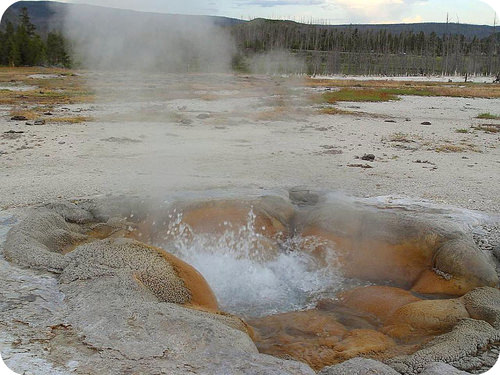20.7 国家和自由能源的改变
章节大纲
-
How are energy and changes of state related?
::能源和国家变化如何相关?Energy in a body of water can be gained or lost depending on conditions. When water is heated above a certain temperature steam is generated. The increase in energy creates a higher level of disorder in the water molecules as they boil off and leave the .
::水体中的能量可以随着条件而获取或丧失,当水在一定温度蒸汽之上加热时,产生的能量会增加,导致水分子在沸腾和离开时出现更高程度的紊乱。Changes of State and Free Energy
::国家和自由能源的变化At the temperature at which a occurs, the two states are in equilibrium with one another. For an ice-water system , equilibrium takes place at 0°C, so Δ G ° ∘ is equal to 0 at that temperature. The heat of fusion of water is known to be equal to 6.01 kJ/mol, and so the Gibbs equation can be solved for the entropy change that occurs during the of ice. The symbol Δ S fus represents the entropy change during the melting process, while T f is the point of water.
::当温度发生时,两个州之间是平衡的。对于冰水系统来说,平衡是在0°C,因此当温度为0时,G等于0。已知水聚变的热等于6.01kJ/mol,因此Gibbs等式可以解决冰下发生的星团变化。符号 Sfus 代表熔化过程中的星团变化,Tf是水的点。Δ G = 0 = Δ H − T Δ S Δ S fus = Δ H fus T f = 6.01 kJ/mol 273 K = 0.0220 kJ/K ⋅ mol = 22.0 J/K ⋅ mol
::@G=0H-TSSSFus*HfusTf=6.01 kJ/mol273 K=0.0220 kJ/Kmol=22.0 J/KmolThe entropy change is positive as the solid state changes into the liquid state. If the transition went from the liquid to the solid state, the numerical value for Δ S would be the same, but the sign would be reversed since we are going from a less ordered to a more ordered situation.
::随着固态向液态的转变,酶的变化是正的。 如果从液体向固态的转变发生,则-S的数值会相同,但信号会倒转,因为我们从一个更不固定的状态向一个更有序的局面转变。A similar calculation can be performed for the vaporization of liquid to . In this case we would use the molar heat of vaporization . This value would be 40.79 kJ/mol. The Δ S vap would then be as follows:
::对液体蒸发可作类似的计算。在这种情况下,我们将使用蒸发的摩尔热。这一数值为40.79kJ/mol。Δ S = 40.79 kJ/mol 373 K = 0.1094 kJ/K ⋅ mol = 109.4 J/K ⋅ mol
::S=40.79 kJ/mol373 K=0.1094 kJ/Kmol=109.4 J/KmolThe value is positive, again reflecting the increase in disorder going from liquid to vapor . from vapor to liquid would give a negative value for Δ S .
::其值为正值,再次反映从液体到蒸气的紊乱增加。 从蒸气到液体,其负值将为 ++S 带来负值。Summary
::摘要-
Calculations are shown for determining entropy changes at transition temperatures (ice → water or water → vapor and reverse).
::为确定过渡温度(水或水蒸气和逆向)下的酶变化,列出了计算方法。
Review
::回顾-
What precautions need to be taken in selecting a value for
Δ
H
?
::选择 QH 值时需要采取哪些预防措施? -
Why is temperature selection important?
::为什么选择温度很重要? -
Why would the entropy of vaporization be so much larger than the entropy of fusion?
::为什么蒸发的环球比聚变的环球还要大?
-
Calculations are shown for determining entropy changes at transition temperatures (ice → water or water → vapor and reverse).
